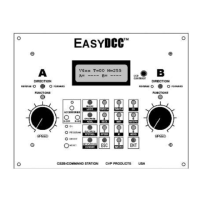127
Simplified Troubleshooting When The Trains No Longer Run
Troubleshooting is not a scary. In fact, if you read and follow the suggestions in this section,
you’ll be troubleshooting like a pro. A professional troubleshooter tackles problems by using
simple tests to decide where to focus his efforts. For an EasyDCC system, the tests are very
simple and easy to perform without any expensive equipment. The assumption for this section is
that one or more trains where running just fine but now they have stopped.
If none of the previous page’s tips have helped, the following procedures will help find the cause
of the trouble. It is important that you follow these procedures exactly as described and in
sequence. Do not skip around. The big assumption for this section is that everything was working
normally when the trains were last used.
Step 1: Check for power on the rails. The easiest way to do this is to use a clip lead and short
across the rails in the area in which the train doesn’t run. The short circuit buzzer should sound off
and the red fault light will light up on the ZoneMaster booster feeding this area. This proves there
is DCC power on the rails and that the booster is working correctly. If the short circuit test works
and the alarm sounds, proceed on to step 2. If the alarm doesn’t sound, go to next page and find
“step 1 failed.”
Step 2: Checks for correct Command Station and booster operation. Next, turn off all wireless
throttles and unplug all plug-in throttles. This is very important. Setup the Command Station’s
built in “A” throttle to the loco number that is not running. Check the display on the Command
Station. Use the following key sequence to setup the Command Station’s A throttle to the loco
number. Note that the loco number is shown by “nnnn.” You substitute your loco number for
nnnn. You also need to deassign the B throttle.
SETUP, THROT-A, nnnn[the loco number used for the test], ENT, ESC.
SETUP, THROT-B, ENT, ESC
Verify that the display shows A=nnnn [your loco number] and the B throttle shows dashes.
Now turn up the A speed control and check if the loco moves. Change the A direction and check if
the loco moves in the other direction. If the loco does not move, go to step 3. If the loco does
move, go to next page - Loco moves at step 2.
Step 3: Reprogram the loco number. Move the test loco from the step 2 to the programming track
with all wheels on the rails. Use the following keys to reprogram the loco decoder to the desired
number. Again, as before, the loco number is shown as “nnnn” and you use whatever number you
want. Most people use the locomotive’s cab number since it is easily seen.
Push the SVC PRGM key. There are two possible messages that will appear after pushing this
key. Find the column that matches your display for what to do next.
Program Track
Program What?
Program Track
Program What?
Decoder Type=02
ENT=OK or 1,2,3
Program Track
Loco Addr ____?
Program Track
Loco Addr ____?
Prog Address OK
PgmPT:What else?
Prog Address OK
PgmPT:What else?
Push the SHOW/LOCO key.
Push the 3 key.
Push the SHOW/LOCO key.
Enter the desired loco number and then
press ENT.
Enter the desired loco number and then
press ENT.
Push ESC.
Go to to step 4.
Push ESC.
Go to step 4.

